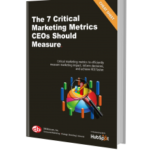Are your marketing analytics lying to you?
As a CEO, CMO or business leader, you have a lot of decisions to make that impact the success of your organization.
And many of those decisions have to do with when, where, and how you invest your marketing and sales dollars to provide the optimum profitability.
Many companies fork out a considerable investment in marketing. Harvard Business Review estimates global media spending will increase 30% to $2.1 trillion from 2014 to 2019. Yet, as much as 60% of digital media spend is wasted every year. Ouch!
While your marketing budget may be slightly less, you want every marketing dollar to count. And, you depend on your marketing analytics data to help you get it right.
But, what if your marketing analytics are lying to you? Data tells a story. Even when the numbers are accurate, the story told by the data can be incomplete, misinterpreted or biased. To make matters worse, focusing on the wrong metrics can lead to decisions that can cost you time, money and market share.
Before you give up on your data, here’s why your marketing metrics could be lying to you – and how to fix them.
1. Your marketing metrics may not be aligned with your strategy
Marketing analytics without strategy is just a bunch of numbers
Do your marketing metrics help you do this?
- Tie bottom-line revenue to specific marketing activities?
- Identify high ROI activities and use the data to inform future investments?
- Find out where your most profitable customers are coming from?
- Predict the payback time for your marketing investments?
- Inform critical business decisions?
If the answer is no, you are not alone.
In fact, 73% of business leaders say they need more from their data to better inform their decisions. If your metrics aren’t telling you what you really want to know, it could be because your KPI dashboard is not aligned with your business strategy.
Strategy is the anchor for planning, executing, and measuring marketing’s contribution to business growth
The first step to getting a true picture of your marketing progress is to start with a solid strategy. Do your organizational goals include long-term brand awareness or an increase in visibility? Possibly a successful product launch or an increase in market share? Or maybe you want to expand geographically or increase profitability.
A solid marketing strategy helps define the current state of business and outlines the goals for your marketing efforts. By starting with a clearly defined picture of where you want to be, you can then build a very specific plan of actions that will help you achieve your goals. Otherwise known as a marketing plan.
Strategic marketing plans help business leaders:
- Define and diagnose current situations
- Create a roadmap for tactical actions
- Prioritize sales and marketing efforts as they relate to organizational goals
- Guide decisions, direct action and rule out other approaches
- Prioritize where marketing dollars should be invested
- Execute with speed and agility
Google maps for your marketing
Think of your strategy and marketing plan kind of like Google Maps. Your strategy is your destination and your marketing plan is the shortest route to get there. Sure, you may be able to find your way without it. But you’ll probably take a lot of wrong turns, waste valuable time and resources.
A strategic marketing plan connects your marketing activities with your business objectives, provides a roadmap for optimal marketing productivity, and reveals which metrics will accurately measure your progress.
2. You marketing analytics aren’t focused on the metrics that matter
Stop measuring everything that moves. Measure what moves the needle.
There’s an abundance of marketing analytical tools available today. And these tools give business leaders the ability to make decisions that will increase growth and marketing return on investment (MROI). Yet, this abundance of choices can be overwhelming and paralyzing to organizations when there’s too much data, but not enough answers.
Quantum theory of marketing- “energy flows where attention goes”
(Ok, pardon the quantum puns on matter and energy.)
Although it may sound complicated, the law of quantum physics states that everything is made of energy. And these subatomic particles of energy can exist in all possible states (or possibilities) at the same time until they are observed and measured. At which point they come into ‘existence’. Mind-bending yes, but the concept applies to strategic marketing plans and analytics as well.
Strategic marketing plans determine focus and appropriate metrics
Your organization has infinite possibilities in the marketplace. By stating your strategic goals (strategy), and defining your tactics (marketing plan), you begin to focus your attention and energy on bringing those specific goals into existence.
In other words, your strategy drives your focus. Your marketing plan drives your energy and efforts. And boom, you are now a quantum marketer!
Once you develop specific marketing tactics to reach your goals, deciding which marketing metrics to ‘observe’ becomes much easier. Following this same principle, you’ll also have a clear picture of what does not need to be observed or measured in your high-level KPI dashboard.
3. Your marketing data may not be seamless & integrated
The availability of robust marketing data can be a powerful tool to drive strategic growth. But, if your data is siloed in departmental buckets, or between various data collection tools – you may not be harnessing the full potential.
End-to-end customer view
Consumer behavior has changed dramatically over the past few years. And, so have the tools marketers use to attract, nurture, and convert prospects into customers. Modern sales and marketing methodologies focus on the customer buying journey, which can be complex and dynamic. And have countless touch points and moments of influence that impact customer behavior.
With this level of complexity, it’s critical to have a complete picture of the customer journey – from the first touch to acquisition, to retention. Many organizations have siloed data. For example, sales and marketing may have different views of the customer as the customer is ‘passed’ off from a marketing-qualified lead (MQL) to a sales-qualified lead (SQL).
This segregation of data can make investment decisions even more complicated as critical information such as customer acquisition costs (CAC) and lifetime value of a customer (LTV) become difficult to determine.
Attribution challenges
Attributing specific marketing and sales activities to bottom-line revenue has always been complicated. In today’s convoluted and complex sales funnel, it remains a tough nut to crack, even with mounds of data available. For example, it may be easy (and convenient) to tie revenue to digital ads when the reports can detail your CTR (click-through-rate), CR (conversion rate), and even CPL (cost per lead) and CPS (cost per sale).
The challenge with these types of campaign metrics is that they only show the last-touch of the customer. They do not consider the previous touch points of the customer such as the email they read last week, or the social media posts they engaged with you in. By assigning attributing the full revenue of the sale to only the last touch of contact, your MROI analysis will be missing key costs. And, you’ll have gaps in your knowledge of your true customer journey.
To help solve for the full customer journey and attribution challenges, look for ways to aggregate data from different silos. Data automation and reporting tools such as HupSpot, Marketo or Pardot can be a cost-effective solution for a seamless view of customer behavior, as well as robust reporting for a better understanding of how your customers engage with you at all touch points.
Use multiple layers of integrated data for a holistic view
In addition to creating a seamless view of the customer journey and touch points, integrated data also allows you to look beyond simple campaign metrics when deciding how to allocate future marketing dollars.
For example, one campaign may appear to yield great conversions, but how do you know the conversions are great customers? Not all customers are created equal as some will turn out to be repeat customers for many years and have a lifetime value (LTV) much greater than others.
To maximize marketing productivity and long-term profitability, it’s best to integrate specific campaign or marketing activity metrics with key ‘big-picture’ or revenue productivity metrics.
Big-picture, revenue-focused metrics
Metrics such as LTV (customer lifetime value) and MROI (marketing return on investment) can provide a holistic picture of profitability, as well as at the campaign level. If cash flow or process improvement are concerns, metrics such as Time to Payback CAC (customer acquisition costs) and M%-CAC (marketing share of CAC) can be very insightful to help improve performance across an entire segment of sales and marketing activities.
These ‘always measured’ metrics can reveal deep insight into marketing’s impact on bottom-line revenue. Read more about revenue optimization (RoFu) metrics every CEO should measure.
Campaign-focused metrics
Campaign metrics help you observe and report on very detailed performance at the campaign level. These metrics vary greatly depending on the marketing tools used. These metrics include open rate (OR), impressions, click-through-rate (CTR), conversion rate (CR), cost per lead (CPL) and many more.
The ultimate trick to choosing marketing metrics that work for your organization is to start with your strategy and strategic marketing plan to better understand what you need to measure.
Then, develop a holistic set of marketing KPIs that give you the complete, unbiased story. Utilize data integration and automation tools such as HubSpot to provide a seamless view of customer touch points and behaviors. This will include both high-level, revenue-focused KPIs, as well as targeted metrics for each campaign (and product/service level) that may evolve over time.
Recap
As a business leader, you want to make sure every dollar spent on marketing is an investment that pays off for the business. The availability of marketing data these days isn’t a problem. But not using it correctly can waste valuable resources and cost you market share.
A solid strategy and marketing plan helps clarify activities that align with corporate goals and brings into focus specific marketing analytics to accurately report performance. Combined with integrated data and a seamless view of the customer journey, decision-making firepower is in your hands.
Have questions about your marketing metrics or aligning your business strategy to marketing activities for better bottom line results? We’re here to help—contact us today.
Looking for more information on marketing metrics?
Download this free ebook “7 Marketing Metrics CEOs Should Measure” to help you:
- Get accurate metrics for more informed, data-driven decisions
- Reduce unprofitable marketing costs
- Increase productivity and speed to market
- Focus on high-payoff activities
About DB Marcom
DB Marcom helps small to mid-sized businesses market smarter, faster, and more profitably…without adding overhead. We are a full-service marketing partner providing outsourced and managed services for strategy, branding, digital and inbound marketing. DB Marcom is a strategy-first agency with a focus on building integrated marketing systems that attract, engage and convert profitable customers.
No more thrashing. No more chaos. No more wasted marketing dollars. We’ll focus on the details so you can focus on your running your business. Contact us today to find out how we can help you.
DB Marcom, Inc.
Marketing > Strategy | Branding | Digital
info@dbmarcom.com
www.dbmarcom.com





2 Comments